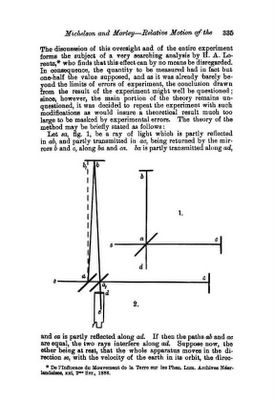1887: "Speed of light is Constant"

Drawing of interferometer from Michelson-Morley's paper published in
1887 in "The American Journal of Science"

... As we were saying, at the end of the 19th century some physicists
were thinking that Physics was coming to an end. Nothing more about
physical phenomena needed to be known. All of the underlying
principles behind all interactions between "bodies" have been
understood well.
There were a few problems though. One was an outcome of the
experiment by Michelson and Morley using interferometer in which they
sent light in two directions and then brought those back. If speed of the
light is different in these two paths, that information would be carried by
light in the form of what is called "phase" and can be detected by
combining these two lights together.
We all know that if we sail along with the flow of the river, our speed
increases but if we wish to move the opposite way, the speed decreases.
Now if, the interferometer is placed in such a way that one arm points
to north and another east, then light going in the 2nd arm should have
less or more speed than the actual speed of light due to motion of earth in
West to East direction, but the light in the 1st arm will not experience
any change in speed because it's travelling in the north direction.
Michelson's experiment showed : No. Under any circumstances, light
does not change its speed. It is always constant - it does not change.
This went completely against common instinct derived from Newtonian
'classical' physics. Two horses A and B are running side by side with
speed of 25 miles per hour (mph) and 30 mph respectively. What is the
speed of B with respect to A? Answer: 5 mph. What if they run opposite
to each other? Answer: 55 mph. Too simple.
But the same simple math does not apply between a horse and a light
beam. Whatever be the speed of horse, even if it is an extragalactic
superfast one, it will measure the speed of light to be a constant -
about 299 792 458 meter/second.
Confusing?! Yes. In 1900 many physicists were as confused as you are.
Almost everything of Physics seemed to be known and understood ...
except a handful few problems: Speed of light was one such pain which
needed to be cured !

0 Comments:
Post a Comment